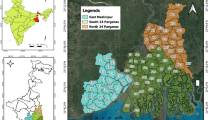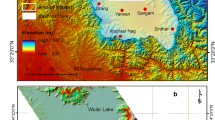Abstract
Sea-level rise (SLR) threatens islands and coastal communities due to vulnerable infrastructure and populations concentrated in low-lying areas. LiDAR (Light Detection and Ranging) data were used to produce high-resolution DEMs (Digital Elevation Model) for Kahului and Lahaina, Maui, to assess the potential impacts of future SLR. Two existing LiDAR datasets from USACE (U.S. Army Corps of Engineers) and NOAA (National Oceanic and Atmospheric Administration) were compared and calibrated using the Kahului Harbor tide station. Using tidal benchmarks is a valuable approach for referencing LiDAR in areas lacking an established vertical datum, such as in Hawai‘i and other Pacific Islands. Exploratory analysis of the USACE LiDAR ground returns (point data classified as ground after the removal of vegetation and buildings) indicated that another round of filtering could reduce commission errors. Two SLR scenarios of 0.75 (best-case) to 1.9 m (worst-case) (Vermeer and Rahmstorf Proc Natl Acad Sci 106:21527–21532, 2009) were considered, and the DEMs were used to identify areas vulnerable to flooding. Our results indicate that if no adaptive strategies are taken, a loss ranging from $18.7 million under the best-case SLR scenario to $296 million under the worst-case SLR scenario for Hydrologically Connected (HC; marine inundation) and Hydrologically Disconnected (HD; drainage problems due to a higher water table) areas combined is possible for Kahului; a loss ranging from $57.5 million under the best-case SLR scenario to $394 million under the worst-case SLR scenario for HC and HD areas combined is possible for Lahaina towards the end of the century. This loss would be attributable to inundation between 0.55 km2 to 2.13 km2 of area for Kahului, and 0.04 km2 to 0.37 km2 of area for Lahaina.





Similar content being viewed by others
References
ASPRS (2004) ASPRS guidelines vertical accuracy reporting for LiDAR data, vol.1.0. http://www.asprs.org/a/society/committees/standards/standards_comm.html. Accessed 22 August 2011
CCSP (2009) Synthesis and assessment product 4.1: coastal sensitivity to sea-level rise: a focus on the Mid-Atlantic region. U.S. Climate Change Program, Washington, DC
Chen Q (2007) Airborne LiDAR data processing and information extraction. Photogramm Eng Rem Sens 73:109–112
Chen Q, Gong P, Baldocchi DD, Xie G (2007) Filtering airborne laser scanning data with morphological methods. Photogramm Eng Rem Sens 73:171–181
FGDC (1998) Geospatial positioning accuracy standards, Part 3. National Standard for Spatial Data Accuracy. FGDC-STD-007.3-1998. http://www.fgdc.gov/standards/projects/FGDC-standards-projects/accuracy/part3/index_html. Accessed 22 August 2011
Fletcher CH (2009) Sea level by the end of the 21st century: a review. Shore & Beach 77:4–12
Fletcher C, Boyd R, Grober-Dunsmore R, Neal WJ, Tice V (2010) Living on the shores of Hawai‘i. University of Hawai‘i Press, Honolulu
Genz AS, Fletcher CH, Dunn RA, Frazer LN, Rooney JJ (2007) The predictive accuracy of shoreline change rate methods and alongshore beach variation on Maui, Hawaii. J Coast Res 23:87–105. doi:10.2112/05-0521.1
Gesch DB (2009) Analysis of LiDAR elevation data for improved identification and delineation of lands vulnerable to sea-level rise. J Coast Res 53:49–58. doi:10.2112/S153-006.1
GOF (2011) The Global Oceans Forum report of activities 2010. www.globaloceans.org. Accessed 22 august 2011
Henman J, Poulter B (2008) Inundation of freshwater peatlands by sea level rise: Uncertainty and potential carbon cycle feedbacks. J Geophys Res 113:G01011. doi:10.1029/2006JG000395
IPCC (2007) Climate change 2007, the physical science basis. Cambridge University Press, Cambridge
Liu XY (2011) Accuracy assessment of LiDAR elevation data using survey marks. Surv Rev 43:80–93. doi:10.1179/003962611X12894696204704
Marcy D, Brooks W, Draganov K, Hadley B, Haynes C, Herold N, McCombs J, Pendleton M, Ryan S, Schmid K, Sutherland M, Waters K (2011) New mapping tool and techniques for visualizing sea level rise and coastal flooding impacts. In: Wallendorf LA, Jones C, Ewing L, Battalio B (eds) Proceedings of the 2011 Solutions to Coastal Disasters Conference, Anchorage, Alaska, June 26 to June 29, 2011., pp 474–90, Reston, VA: American Society of Civil Engineers. http://csc.noaa.gov/digitalcoast/tools/slrviewer/support.html#cite1. Accessed 17, March 2012
McLeod E, Poulter B, Hinkel J, Reyes E, Salm R (2010) Sea level-rise impact models and environmental conservation: a review of models and their applications. Ocean Coast Manage 53:507–517. doi:10.1016/j.ocecoaman.2010.06.009
Maune DF (2007) DEM User Requirements. In: Maune DF (ed) Digital elevation model technologies and applications: the DEM users manual, 2nd edn. American Society for Photogrammatry and Remote Sensing, Bethesda, pp 449–473
Nicholls RJ (2011) Planning for the impacts of sea level rise. Oceanography 24:144–157. doi:10.5670/oceanog.2011.34
NOAA (2001) Tidal datums and their applications. NOAA special publication NOS CO-OPS 1. NOAA National Ocean Service, Silver Spring
NOAA (2008) Topographic and bathymetric data considerations: datums, datum conversion techniques, and data integration. Technical Report NOAA/CSC/20718-PUB. National Oceanic and Atmospheric Administration, Charleston, SC
NOAA (2009) Sea level variations of the United States 1854–2006. Technical Report NOS CO- OPS 053. NOAA National Ocean Service, Silver Spring
NOAA (2010) Technical considerations for use of geospatial data in sea level change mapping and assessment. NOAA NOS Technical Report. NOAA National Ocean Service, Silver Spring
NOAA (2011) Digital Coast, NOAA Coastal Services Center. http://csc.noaa.gov/digitalcoast/tools/slrviewer/support.html#cite1. Accessed 17, March 2012
Poulter B, Halpin PN (2008) Raster modeling of coastal flooding from sea-level rise. Int J Geogr Inf Sci 22:167–182. doi:10.1080/13658810701371858
Rotzoll K, El-Kadi AL (2008) Estimating hydraulic properties of coastal aquifers using wave setup. J Hydrol 353:201–213. doi:10.1016/j.jhydrol.2008.02.005
Rotzoll K, El-Kadi AL, Gingerich SB (2008) Analysis of an unconfined aquifer subject to asynchronous dual-tide propagation. Ground Water 46:239–250. doi:10.1111/j.1745-6584.2007.00412.x
US Census Bureau (2011) The 2011 statistical abstract of the United States. US Census Bureau. Washington, DC. http://www.census.gov/compendia/statab/. Accessed 22 August 2011
Vermeer M, Rahmstorf S (2009) Global sea level linked to global temperature. Proc Natl Acad Sci 106:21527–21532. doi:10.1073/pnas/.0907769106
Wu SY, Yarnal B, Fisher A (2002) Vulnerability of coastal communities to sea-level rise: a case study of Cape May County, New Jersey, USA. Clim Res 22:255–270
Zhang K (2011) Analysis of non-linear inundation from sea-level rise using LiDAR data: a case study for South Florida. Clim Change 106:537–565. doi:10.1007/s10584-010-9987-2
Zhang K, Dittmar J, Ross M, Bergh C (2011) Assessment of sea level rise impacts on human population and real property in the Florida Keys. Clim Change 107:129–146. doi:10.1007/s10584-011-0080-2
Acknowledgments
We appreciate comments by three anonymous reviewers. Data were provided by the NOAA CSC, NGS, Hawai‘i Statewide GIS Program, and DigitalGlobe. This study was funded by a grant from the U.S. Department of Interior Pacific Islands Climate Change Cooperative.
Author information
Authors and Affiliations
Corresponding author
Rights and permissions
About this article
Cite this article
Cooper, H.M., Chen, Q., Fletcher, C.H. et al. Assessing vulnerability due to sea-level rise in Maui, Hawai‘i using LiDAR remote sensing and GIS. Climatic Change 116, 547–563 (2013). https://doi.org/10.1007/s10584-012-0510-9
Received:
Accepted:
Published:
Issue Date:
DOI: https://doi.org/10.1007/s10584-012-0510-9




